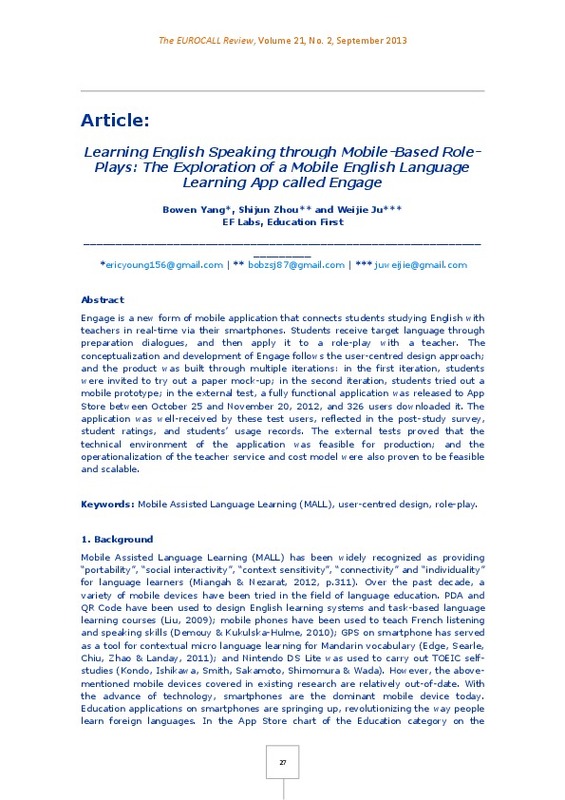Burke, T. & Guest, A. (2010). Using role playing as a teaching strategy: an interdisciplinary approach to learning. Proceedings of the 2nd Annual Conference on Higher Education Pedagogy, 34-35.
Buzan, T. (1989). Use both sides of your brain. New York: Penguin.
Demouy, V. & Kukulska-Hulme, A. (2010). On the spot: using mobile devices for listening and speaking practice on a French language programme. Open Learning: The Journal of Open, Distance and e-Learning, 25(3), 217-232. https://doi.org/10.1080/02680513.2010.511955
[+]
Burke, T. & Guest, A. (2010). Using role playing as a teaching strategy: an interdisciplinary approach to learning. Proceedings of the 2nd Annual Conference on Higher Education Pedagogy, 34-35.
Buzan, T. (1989). Use both sides of your brain. New York: Penguin.
Demouy, V. & Kukulska-Hulme, A. (2010). On the spot: using mobile devices for listening and speaking practice on a French language programme. Open Learning: The Journal of Open, Distance and e-Learning, 25(3), 217-232. https://doi.org/10.1080/02680513.2010.511955
Edge, D., Searle, E., Chiu, K., Zhao, J. & Landay, J.A. (2011, May). Micromandarin: mobile language learning in context. 2011 Annual Conference on Human Factors in Computing Systems. Symposium conducted in Vancouver, BC, Canada.
Hyerle, D. (2004). Student successes with thinking maps: school-based research, results, and models for achievement using visual tools. CA: Corwin Press. ISO 13407 (1999). Human-centred design processes for interactive systems. London: British Standards Institution.
Karat, C. (1997). Cost-justifying usability engineering in the software life cycle. In M. Helander, T.K.Landauer and P.Prabhu (Eds.), Handbook of Human-Computer Interaction (pp. 653-688). Amsterdam: Elsevier. https://doi.org/10.1016/B978-044481862-1.50098-4
Kondo, M., Ishikawa, Y., Smith,C., Sakamoto, K., Shimomura, H., and Wada,N. (2012). Mobile assisted language learning in university EFL courses in Japan: developing attitudes and skills for selfregulated learning. ReCALL, 24, 169187. https://doi.org/10.1017/S0958344012000055
Kukulska-Hulme, A. and Shield, L.(2008). An overview of mobile assisted language learning: from content delivery to supported collaboration and interaction. ReCALL, 20(3), 271-289. https://doi.org/10.1017/S0958344008000335
Kujala,S. (2003). User involvement: a review of the benefits and challenges. Behavior & Information Technology, 22(1),1-16. https://doi.org/10.1080/01449290301782
Liu, T.-Y. (2009). A context-aware ubiquitous learning environment for language listening and speaking. Journal of Computer Assisted Learning, 25(6), 515-527. https://doi.org/10.1111/j.1365-2729.2009.00329.x
Miangah, T. M., and Nezarat, A. (2012). Mobile-assisted language learning. Journal of Distributed and Parallel Systems, 3(1), 309-319. https://doi.org/10.5121/ijdps.2012.3126
Parrish, B. (2004). Teaching adult ESL: a practical introduction. New York: McGraw-Hill Companies.
Rubin, J. (1994). Handbook of usability testing: how to plan, design, and conduct effective tests. New York: Wiley.
Schafer, R. W. (1994). Scientific Bases of Human-Machine Communication by Voice. In D.B. Roe (Eds.), Voice communication between humans and machines(pp.34-75). Washington, D.C.: National Academy Press.
Senf, M. (2012, Dec). Role-play, simulations and drama activities. DocumBase. Retrieved from http://en.convdocs.org/docs/index-44311.html
Snyder, C. (2003). Paper prototyping: the fast and easy way to design and refine user interfaces. San Diego, CA: Morgan Kaufmann Pub.
Sousa, D. A. (2006). How the brain learns. CA: Corwin Press.
Traxler, J. (2007). Current state of mobile learning. International Review on Research in Open and Distance Learning, 8(2), 9-24.
[-]







![HTML file [HTML]](/themes/UPV/images/html.png)

